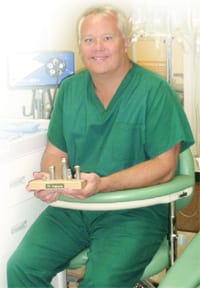Dr. Janice Yanni says that establishing relationships with patients and watching children grow are among the things she loves most about her profession.
Most people don’t think about their teeth unless they are living with dentures or until they lose a tooth or a number of them and are forced to do something about the problem.
In the past, their options were limited. But today, smiles can be restored and dentures can be firmly secured through the use of dental implants.
“For years, dentists lamented that when they removed a tooth they wanted to put something back into the space that looked and operated like a real tooth. Dental implants have solved that problem,” said oral and maxilliofacial surgeon Dr. William J. Bontempi of Berkshire Facial Surgery in Hadley, Longmeadow, and Westfield.
Dental implants can be put in a person’s mouth in less than 45 minutes using novocaine or a local anesthetic. They are stronger than the roots of real teeth, integrate with the patient’s natural bone, are immune to decay, and cost about the same as a bridge.
“I have put in as many as 18 implants in one patient in one surgery,” Bontempi said, adding they have a 97 {06cf2b9696b159f874511d23dbc893eb1ac83014175ed30550cfff22781411e5} success rate. “The vast majority of failures come when people have implants put in by practitioners who lack experience and knowledge about potential complications that can occur.”
Family dentist Kelly Bouchard of Kelly Bouchard, D.M.D., P.C. of West Springfield says dental implants are the standard of care used to replace one or more teeth and make more sense than a bridge since healthy teeth don’t have to be ground down, which is necessary for a bridge to be attached to them.
“I have had two implants for 10 years now and I love them. They will never need a root canal or get a cavity,” she said. “They were the best way to replace my missing teeth because implants look and function like natural teeth. They also fit securely (to dentures) when you are chewing or speaking, and maintain the bone.”
The story of successful dental implants began in 1952 when Swedish orthopedic surgeon/research professor Ingvar Branemark and his team discovered that they couldn’t remove titanium implants they had placed in rabbits’ thighbones because the bone had fused or integrated with it.
That led Branemark to develop and test dental implants made from hollow titanium screws, which he termed “fixtures.” His research continued into the ’70s and he began doing trial procedures using titanium implants in humans.
“In Sweden, the system of social medicine allowed the work to progress faster than would have been possible in the U.S.,” Bontempi said. “It was amazing and fortuitous to the world of dentistry.”
Branemark presented his success story to the world in 1978 at the first Dental Implant Consensus Conference, which was sponsored jointly by the National Institutes of Health and Harvard University. His research made history, because prior to his groundbreaking discovery, dental implant surgery was rarely done as it involved putting a metal blade and screws into the jawbone which did not hold securely in place.
“Branemark was a brilliant researcher but he never patented his research, and within two years a dozen companies began making the implants. It got to be a free for all,” Bontempi said.
Today, the Nobel-Biocare (formerly Branemark) and Straumann companies are the two primary manufacturers of titanium implants, although Straumann has more penetration into the world market, which is a $10 billion business.
“As a result of Branemark’s findings, the way plans are made for tooth replacement has changed significantly,” said prosthodontist Dr. Vincent Mariano of Emirzian, Mariano & Associates of East Longmeadow and Northampton.
“For the first time, we were able to replace a non-removable tooth in the human body and have it attach to human bone,” he said. “Implants can be used for a single tooth, for multiple teeth, or to stablize a denture. We can even replace a full set of teeth that are non-removable using multiple implants.”
Technological Advances
Most people are excellent candidates for implants, said those we spoke with, although smokers and individuals with diabetes or other chronic conditions may have more healing challenges.
“But even minor problems with healing can usually be resolved … so many lives have been changed because of the simple discovery that the body can accept a titanium implant and support a tooth through osseointegration,” said Mariano, referring to the process by which the substance is integrated into the bone.
Implants have radically changed the lives of people with dentures, since putting in as few as two can stabilize a full set of lower dentures and keep them from moving via a system of tiny snaps that hold the appliances in place.
“Even people with partial dentures can benefit immensely,” Mariano said. “Dental implants were first developed for denture patients because they had such a poor quality of life.”
Bontempi agrees. “Dentures are typically held in by suction and gravity and people lose 90{06cf2b9696b159f874511d23dbc893eb1ac83014175ed30550cfff22781411e5} of their chewing force when they get them,” he said. “But a study done in Canada shows that implants with dentures will restore chewing ability to 80{06cf2b9696b159f874511d23dbc893eb1ac83014175ed30550cfff22781411e5} of pre-extraction levels. They are not as good as natural teeth, but nearly as good. We can improve a person’s life so much with just a few implants,” Bontempi added.
An additional advantage is that implants strengthen the bone.
“Teeth hold bone in place and any time you lose a tooth the body reabsorbs that part of the jawbone because it is no longer needed,” Bouchard said, adding that when that occurs it can be especially difficult to keep a denture in place.
The first titanium implants had smooth surfaces. “They were made of polished, surgical grade titanium and resembled the surface of a shiny spoon,” Bontempi said. The problem was it could take up to a year for them to integrate with the bone. “People were not happy about having to wait that long before they could attach a permanent crown, bridge, or denture and use it to bite with,” he added.
Two scientific advances accelerated the healing process. The first was coating the implants with hydroxyapatite, which “is the framework of all bones,” Bontempi said. “It gave them a rough texture, stimulated bone regeneration faster, and also made them stronger.”
A problem surfaced, however, when the coating chipped or wore off, which caused the implant to loosen or even worse, led to bone loss and/or chronic infection.
So, Straumann changed the technology, sandblasting the implant’s surface to make it rough, then placing it in acid. The change was recognized by the Food and Drug Administration, which is important, Bontempi said, since implants are medical devices that don’t have to go through the same rigorous FDA testing required to put new drugs on the market.
There are several types of dental implants. Some are known as TADs, or temporary anchorage devices, and are used by orthodontists to prevent back teeth from moving or to limit their movement. TADs, which are smaller in diameter and don’t have the roughened suface of regular dental implants, can also be used to hold temporary bridges or dentures in place. In fact, MDI Implants recently received FDA approval to use them as permanent structures for dentures.
“They are inexpensive and their long-term success is very good,” Bontempi said, explaining that dentures are normally held in by suction and gravity.
Simple procedure
Experts say people who are considering dental implants should ask their dentist to refer them to a specialist who performs the surgery on a frequent basis and has both the training and experience to understand potential complications that may occur.
If there is a question of whether the person’s bone is strong enough to accept an implant, a dental CT or cat scan be taken. Mariano does them in his office and said they can determine whether a patient is a candidate for dental implants before any surgery takes place.
Once the decision to install an implant has been made and the person makes an appointment with a qualified practitioner, the procedure is fast and easy. In fact, it’s not unusual to have a tooth or root pulled and an implant placed into the jaw in the same visit. This is accomplished by using a series of drills which gradually increase in diameter to enlarge the space for the implant.
“It’s important to enlarge the space for the implant gradually, because if the bone was removed all at once it would generate too much heat and would kill it,” Bontempi said, adding that an irrigation unit is attached to the drill to help cool the bone.
The next step is to place the implant into the jaw and add bone-grafting material (if necessary) which is done to fill up extra space or if the person’s bone density needs to be supplemented. In some cases, enough bone is collected from the drilling to use it in the patient’s mouth, while in others, artificial bone is used.
Once that step is complete, a temporary tooth or bridge can be attached to an abutment, which extends from the edge of the gum and is screwed into the hollow interior of the implant. “But the only time it’s really necessary to make a temporary tooth is when aesthetics are a concern,” Bouchard said.
She added that permanent abutments can be made of metal or a new material called white zirconia. “If you are having porcelain crowns, you will want a zirconia abutment because it prevents a metal abutment can leave a grayish line at the gumline,” she said. “Zirconia is a whole new material. It’s better than porcelain and won’t fracture, but has the strength of metal.”
Research has also led to new methods of grafting tissue to the gum when needed. “The trend in all of this is to accelerate the healing process,” Mariano said.
Which leaves people with a beautiful smile and teeth that can’t be distinguished from their natural ones.


